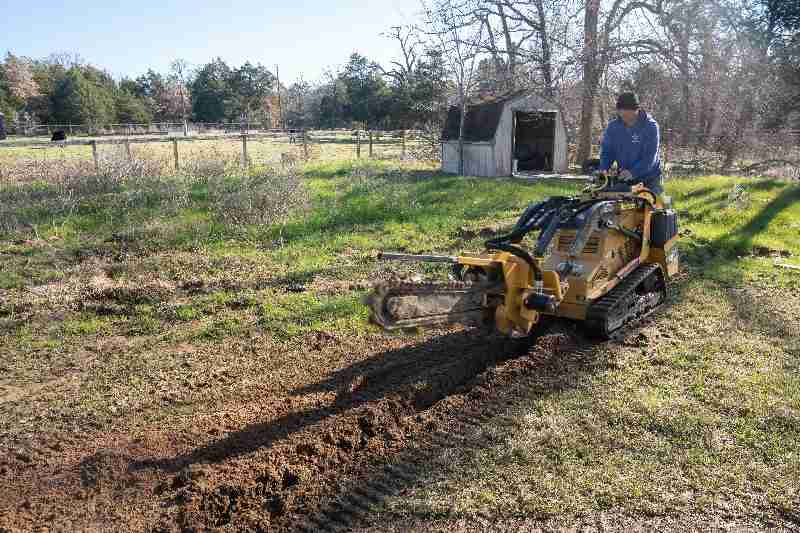In the great state of Texas, when it rains, it pours, especially in Central Texas, the flash flood capital of the United States. Because of the inescapable and temperamental weather, a proper drainage system is of the utmost importance for any house or property in Texas, and a French Drain System is a simple way to route water away from your house and avoid pooling and stagnant water.
What is a French Drain?
A French Drain consists of a trench dug into the ground that houses a perforated pipe and that guides water away from the flooded problem area. There are open and closed systems. In an open system, the pipe is usually wrapped in a landscaping fabric that is water-permeable, so the water seeps through the cloth and through the holes of the corrugated pipe. The cloth also prevents weeds and debris from clogging the holes of the pipe. All of this is then covered with a material that water can easily pass through – gravel is a common choice. The other option is a closed system that typically has a series of openings or catch basin boxes that allow water to flow into them and out of them through a closed pipe buried underground that discharges to a designated area.

How Do French Drains Work?
French Drains are simple and effective because they simply rely on gravity to do most of the work. The other part is choosing materials that don’t block the water from traveling where you want it to go. Using something like gravel allows rainwater to drain through the gravel easily. Beneath the gravel is a pipe with plenty of holes to let the water in. Once the water is in the pipe, it can then move freely onto the chosen drainage area.
Of course, this whole system relies on the trench providing the pipe with a slope from where the water tends to pool up all the way down to where you want to disperse the water. A good rule of thumb for the decline of the trench is 1 inch for every 8 feet. If the trench slopes at this rate, the water should consistently drain properly.
You can decide where the water ends up, preferably a municipal sewer system, but if you have extra space that you don’t mind sending the water, that will work as well. Some systems guide the water into a sort of water basin or rain barrel so that the water can be repurposed for gardens during the drier months.
Different Types of French Drains
There are several variations of a French Drain that all achieve the same goal but have a slightly different visual aesthetic.
Surface French Drains utilize a perforated pipe to drain water away from the problem area, but they do so near the surface. This requires less digging but can be problematic if vehicles are driven over it regularly.
Blind French Drains use the same pipes but are installed deeper into the ground where they aren’t visible.
Trench French Drains are a combination of Surface and Blind French Drains in that they use a perforated pipe underground but also have a grate at the top for water collection.
There are several other names for French Drains according to Wikipedia which all drain water by the same methods: weeping tile, trench drain, filter drain, rubble drain, rock drain, drain tile, perimeter drain, land drain, French ditch, sub-surface drain, sub-soil drain, and agricultural drain.
If you see one of these mentioned, it is the same concept as a French Drain.
When You Should Consider a French Drain
A French Drain is a drainage solution and works for most drainage issues including a soggy front lawn, pooling or standing water, a wet basement or taking pressure off of a retaining wall. In most cases where water redirection is needed, a French Drain can work very well.
When NOT to Install a French Drain
There are two basic necessities for a French Drain to work:
- A slope.
- A place for the water to drain.
If you’re on mostly level ground, a slope can be created by digging the ditch properly, but sometimes, where you can safely direct the water isn’t very convenient for the French Drain System. It’s not acceptable to run water off onto your neighbor’s property and it’s counterproductive if the water ends up causing another detrimental flooding problem elsewhere on your property. Make sure that you have a proper place to drain the water and a convenient way to create a slope if one doesn’t already exist naturally.
How Much Does a French Drain Cost?
Most homeowners have some rerouting of water from the front to the back of their property. For a standard French Drain installation, most homeowners invest $3,500 to $5,500. For more complicated or challenging drainage issues, it is not uncommon to invest up to $10,000 or more to get a properly installed system.
French Drains were actually popularized by Henry Flagg French who was a lawyer and Assistant U.S. Treasury Secretary from Concord, Massachusetts. He refined this style of drain and detailed it in his book, Farm Drainage, published in 1859.

The Perks of Professional French Drain Installation
Installing a French Drain sounds simple, but problems can occur, and when they do, you might not have the time or wherewithal to fix it. If you hire Butler Contracting to install your French Drain System, we’ll make sure that it is done correctly. If there are ever any problems, we’ll come out and make sure to take care of it. Give us a call at (844) 628-8537 or contact us online to get a quote on your drainage solution.



